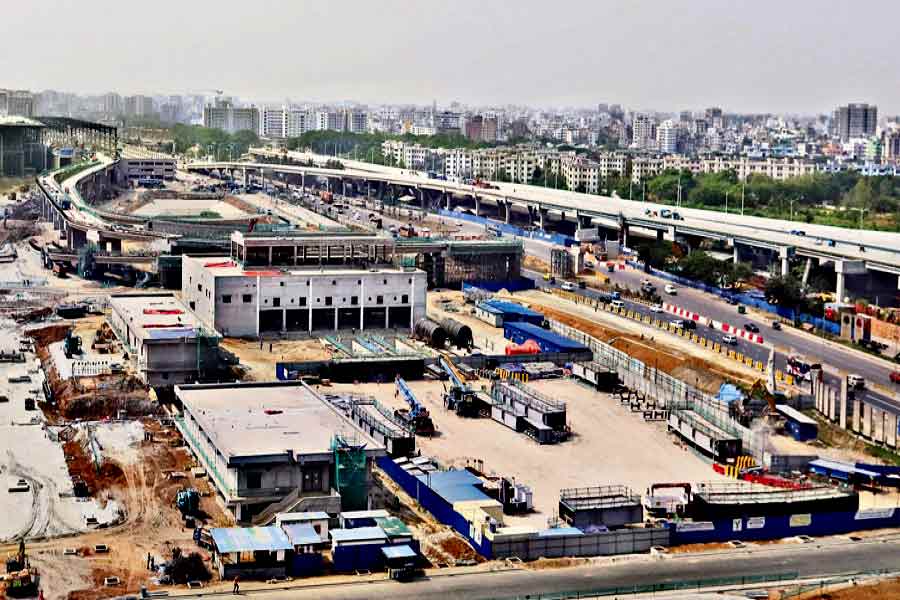
Published :
Updated :

Woes of passengers of the Hazrat Shahjalal International Airport (HSIA) are likely to go with building road infrastructure within and outside the airport through integration with different projects.
However, sources said late integration has slowed down the implementation of the projects, including HSIA 3rd Terminal, Dhaka Elevated Expressway (DEE) and Dhaka BRT (Bus Rapid Transit).
For this reason, airport passengers and common road users need more time to reap the benefits of the facilities.
While integrating, they said, the authorities concerned have to compromise design and costs.
But transport experts speak about the long-term integration benefit due to a mismatch of demand and supply side as the lone north-south road may get huge traffic for development of huge traffic-generated buildings.
According to Prof M Shamsul Hoque, trip generation is likely to multiply for increased airport capacity, allowing mega shopping malls and RAB headquarters.
A study shows the HSIA is likely to get 12-million passengers in 2025, which is to double in 2035.
The HSIA is supposed to get more than 8.0-million passengers by 2028, it discloses.
Officials said the Civil Aviation Authority of Bangladesh (CAAB) has been developing both elevated and surface roads along with two elevated U-flyovers under the terminal project to ensure uninterrupted entry and exit to the airport from all sides of the road, which is linked with Dhaka-Mymensingh highway.
DEE passengers have to take sharp turning after coming down from ramp to get into the airport.
Although airport infrastructure is being built fast compared to other projects, sources said these have blocked the view of the main terminal building to manage integration.
Admitting the fact, CAAB chairman M Mafidur Rahman said integration with other projects has been tried to make the third terminal project a hub of multimodal connectivity.
To accommodate parking space for over 1,200 vehicles and develop approach roads for elevated structures coming through La Meridien and going out from Balaka as well as DEE's ramp, the front view of the terminal building has been blocked from one side.
But Mr Rahman said the infrastructure have been built in a way so that entry and exit vehicles do not mix.
Even links with MRT-01, Haji camp and DEE's own entry and exit have been there.
Sources said the tunnel for MRT-01 Airport station has already been built under the terminal project.
The Roads and Highways Department (RHD), which is building a 323-metre overpass at the airport's original single exit-entry crossing, has already opened one way before Eid-ul-Fitr.
Officials said the overpass would be fully opened before Eid-ul-Azha.
Although it has eased traffic movement towards Uttara and northern districts, project insiders said opening was managed after temporary arrangement without setting up joint bearings as those did not reach the country by that time.
The BRT project added the flyover near the HSIA late to find a solution to untold sufferings by both airport passengers and common traffic since the construction began in 2016.
Although DEE ramps for both entry and exit have already been built, it is found that benefits of this paid infrastructure are unlikely to enjoy by commuters soon for not completing the ramps on other sides of the DEE.
The Bangladesh Bridges Authority (BBA), which is constructing the DEE as a public-private partnership project, has been working to complete the ramps at Tejgaon and Karwanbazar by this year.
The officials said the 4.0-kilometre flyover, built under the BRT project, might lessen public sufferings.
The HSIA is located on Dhaka-Mymensingh highway, which is the lone north-south artery of the city to connect with northern and northeast zone of the country and has already huge industrial belts.
Due to lack of proper traffic management measures on this corridor, passengers and goods laden vehicles have been suffering immensely for the last one decade.
Dr Hoque of Civil Engineering Department said the projects taken so far were to support the supply side of the current situation.
But the change of land use has already generated more trips than infrastructure capacity for which people are unlikely to get the expected service from these investments, he added.
smunima@yahoo.com


 For all latest news, follow The Financial Express Google News channel.
For all latest news, follow The Financial Express Google News channel.